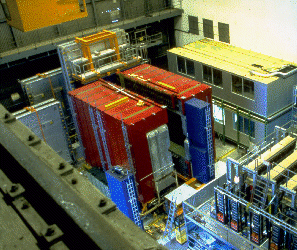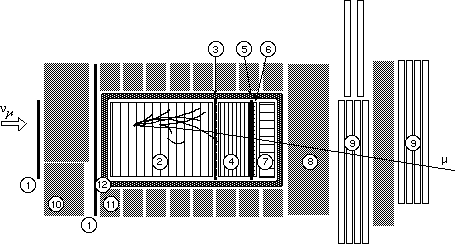|
NOMAD
Neutrino Oscillation MAgnetic Detector |
 |
| Back to NOMAD home page... |
|
Updated : september 1997 |
A complete description of the NOMAD detector can be found in "The NOMAD experiment
at the CERN SPS", submitted to Nuclear Instruments and Methods Phys. Res. A (CERN-PPE/97-059,
May 26th, 1997) ( 23146
Ko).
The NOMAD collaboration is composed of about 150 physicists...
Every 14s, 1013 muon neutrinos ( ) coming from the CERN SPS go through the 3 ton target of the NOMAD detector. At each
burst only one or two neutrino interact. Despite this low rate NOMAD can register up to
500,000 neutrino interactions per year. The hope of physicists is that among these
interactions some are not due to
) coming from the CERN SPS go through the 3 ton target of the NOMAD detector. At each
burst only one or two neutrino interact. Despite this low rate NOMAD can register up to
500,000 neutrino interactions per year. The hope of physicists is that among these
interactions some are not due to  but to tau-neutrino (
but to tau-neutrino ( ).
).
 This discovery would confirm the
neutrino oscillation hypothesis : this fundamental phenomena implies that neutrino are
massive particles. They could then contribute to the hidden mass of the Universe.
Moreover, the standard model of particle physics does not predict any masses for neutrino
and therefore neutrino oscillation would allow an extension of this model.
This discovery would confirm the
neutrino oscillation hypothesis : this fundamental phenomena implies that neutrino are
massive particles. They could then contribute to the hidden mass of the Universe.
Moreover, the standard model of particle physics does not predict any masses for neutrino
and therefore neutrino oscillation would allow an extension of this model.
Finally, in NOMAD if a 

 oscillation is seen, this will lead to the first direct
detection of the
oscillation is seen, this will lead to the first direct
detection of the  (up to now
it has only been indirectly detected via the presence of the tau lepton). If no
(up to now
it has only been indirectly detected via the presence of the tau lepton). If no  is seen , NOMAD will have
contributed to the exploration of the oscillation parameters as already done by many other
experiments these last years. Moreover, thanks to its intrinsic characteristics, NOMAD
will have improved previous studies made by various experiments (CDHS, CHARM and bubble
chamber experiments) on neutrino interactions.
is seen , NOMAD will have
contributed to the exploration of the oscillation parameters as already done by many other
experiments these last years. Moreover, thanks to its intrinsic characteristics, NOMAD
will have improved previous studies made by various experiments (CDHS, CHARM and bubble
chamber experiments) on neutrino interactions.
 beam,
beam,  appearance
appearance
The neutrino beam is produced from 450 GeV protons extracted from the CERN SPS
synchroton. The protons interact on a beryllium target and produce pion and kaon
hadrons that essentially decay into muons and  . At the NOMAD position (940 m further) the beam
contaminations with respect to the main
. At the NOMAD position (940 m further) the beam
contaminations with respect to the main  component, with a mean energy of 24 GeV, are the
following:
component, with a mean energy of 24 GeV, are the
following:
Therefore the observation of  in the detector undoubtly signs an oscillation.
in the detector undoubtly signs an oscillation.
 detection
detection
When an electron-neutrino ( ) or a
) or a  interacts by exchanging a W boson (charged current
reaction) a lepton is produced. This lepton has the same flavor as the incident neutrino,
and it signs the neutrino interaction. The electron is stable, and the probability for a
muon to decay within the detector is very small (life time of 2.2 microseconds). In the
case of the
interacts by exchanging a W boson (charged current
reaction) a lepton is produced. This lepton has the same flavor as the incident neutrino,
and it signs the neutrino interaction. The electron is stable, and the probability for a
muon to decay within the detector is very small (life time of 2.2 microseconds). In the
case of the  , the tau lepton
which is produced immediately decays : its life time is of the order of 10-13
seconds, and in NOMAD its track is less than 1 mm long. The tau lepton cannot therefore be
directly detected. This lepton decays essentially as described in the following table :
, the tau lepton
which is produced immediately decays : its life time is of the order of 10-13
seconds, and in NOMAD its track is less than 1 mm long. The tau lepton cannot therefore be
directly detected. This lepton decays essentially as described in the following table :
Main decay modes of the tau lepton
| Mode |
Probability (%) |
muon, anti- , ,  |
17.4 |
electron,anti- , , |
17.8 |
pion, |
12 |
rho, |
26 |
It is clear that in the two first modes the electron or the muon which
is emitted can be simulated by a  or a
or a  interaction. The crucial difference comes from the fact
that in the decay of the tau lepton produced in a
interaction. The crucial difference comes from the fact
that in the decay of the tau lepton produced in a  interaction there are two neutrinos escaping thus
creating an important missing energy. This missing energy is the way the
interaction there are two neutrinos escaping thus
creating an important missing energy. This missing energy is the way the  interaction is signed in NOMAD.
interaction is signed in NOMAD.
Detector characteristics
 Schematic
view of the NOMAD detector.
The magnet creates a magnetic field perpendicular to that picture. This field bends the
particle trajectories. A  interaction by charged current is shown with identification of the muon inside the muon
chambers.
interaction by charged current is shown with identification of the muon inside the muon
chambers.
|
In order to identify the  candidate, NOMAD has therefore to identify electrons and muons, and has to measure the
energy and the momentum of all the tracks produced during the neutrino interaction in
order to be able to compute with accuracy the missing momentum. The detector needs
therefore to have the following characteristics :
candidate, NOMAD has therefore to identify electrons and muons, and has to measure the
energy and the momentum of all the tracks produced during the neutrino interaction in
order to be able to compute with accuracy the missing momentum. The detector needs
therefore to have the following characteristics :


![]() ) coming from the CERN SPS go through the 3 ton target of the NOMAD detector. At each
burst only one or two neutrino interact. Despite this low rate NOMAD can register up to
500,000 neutrino interactions per year. The hope of physicists is that among these
interactions some are not due to
) coming from the CERN SPS go through the 3 ton target of the NOMAD detector. At each
burst only one or two neutrino interact. Despite this low rate NOMAD can register up to
500,000 neutrino interactions per year. The hope of physicists is that among these
interactions some are not due to ![]() but to tau-neutrino (
but to tau-neutrino (![]() ).
). This discovery would confirm the
neutrino oscillation hypothesis : this fundamental phenomena implies that neutrino are
massive particles. They could then contribute to the hidden mass of the Universe.
Moreover, the standard model of particle physics does not predict any masses for neutrino
and therefore neutrino oscillation would allow an extension of this model.
This discovery would confirm the
neutrino oscillation hypothesis : this fundamental phenomena implies that neutrino are
massive particles. They could then contribute to the hidden mass of the Universe.
Moreover, the standard model of particle physics does not predict any masses for neutrino
and therefore neutrino oscillation would allow an extension of this model. ![]()
![]()
![]() oscillation is seen, this will lead to the first direct
detection of the
oscillation is seen, this will lead to the first direct
detection of the ![]() (up to now
it has only been indirectly detected via the presence of the tau lepton). If no
(up to now
it has only been indirectly detected via the presence of the tau lepton). If no ![]() is seen , NOMAD will have
contributed to the exploration of the oscillation parameters as already done by many other
experiments these last years. Moreover, thanks to its intrinsic characteristics, NOMAD
will have improved previous studies made by various experiments (CDHS, CHARM and bubble
chamber experiments) on neutrino interactions.
is seen , NOMAD will have
contributed to the exploration of the oscillation parameters as already done by many other
experiments these last years. Moreover, thanks to its intrinsic characteristics, NOMAD
will have improved previous studies made by various experiments (CDHS, CHARM and bubble
chamber experiments) on neutrino interactions. ![]() beam,
beam, ![]() appearance
appearance![]() . At the NOMAD position (940 m further) the beam
contaminations with respect to the main
. At the NOMAD position (940 m further) the beam
contaminations with respect to the main ![]() component, with a mean energy of 24 GeV, are the
following:
component, with a mean energy of 24 GeV, are the
following:
![]() in the detector undoubtly signs an oscillation.
in the detector undoubtly signs an oscillation. ![]() detection
detection![]() ) or a
) or a ![]() interacts by exchanging a W boson (charged current
reaction) a lepton is produced. This lepton has the same flavor as the incident neutrino,
and it signs the neutrino interaction. The electron is stable, and the probability for a
muon to decay within the detector is very small (life time of 2.2 microseconds). In the
case of the
interacts by exchanging a W boson (charged current
reaction) a lepton is produced. This lepton has the same flavor as the incident neutrino,
and it signs the neutrino interaction. The electron is stable, and the probability for a
muon to decay within the detector is very small (life time of 2.2 microseconds). In the
case of the ![]() , the tau lepton
which is produced immediately decays : its life time is of the order of 10-13
seconds, and in NOMAD its track is less than 1 mm long. The tau lepton cannot therefore be
directly detected. This lepton decays essentially as described in the following table :
, the tau lepton
which is produced immediately decays : its life time is of the order of 10-13
seconds, and in NOMAD its track is less than 1 mm long. The tau lepton cannot therefore be
directly detected. This lepton decays essentially as described in the following table : ![]() or a
or a ![]() interaction. The crucial difference comes from the fact
that in the decay of the tau lepton produced in a
interaction. The crucial difference comes from the fact
that in the decay of the tau lepton produced in a ![]() interaction there are two neutrinos escaping thus
creating an important missing energy. This missing energy is the way the
interaction there are two neutrinos escaping thus
creating an important missing energy. This missing energy is the way the ![]() interaction is signed in NOMAD.
interaction is signed in NOMAD. 
![]() candidate, NOMAD has therefore to identify electrons and muons, and has to measure the
energy and the momentum of all the tracks produced during the neutrino interaction in
order to be able to compute with accuracy the missing momentum. The detector needs
therefore to have the following characteristics :
candidate, NOMAD has therefore to identify electrons and muons, and has to measure the
energy and the momentum of all the tracks produced during the neutrino interaction in
order to be able to compute with accuracy the missing momentum. The detector needs
therefore to have the following characteristics :